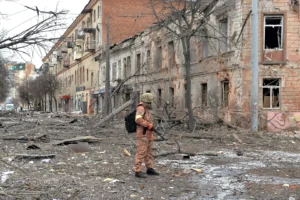So many people want to live in West Greenville, it crashed a website.
“Homes of Hope has about 110 houses in West Greenville,” says Inez Morris. She’s a resident of this neighborhood, and she’s about a dozen kinds of social activist and educator. “And they stay filled. They have a waiting list. They opened up their system [on] the first of September; within the hour it crashed because of the traffic. Within two hours they shut it down because they had more applications than they could take. That’s how bad the housing crisis is in Greenville.”
That’s how bad the housing crisis is for Black residents looking to find affordable housing in historically Black neighborhoods in Greenville, to be exact. And it’s not the kind of conversation anyone would have been having a decade or two ago.
“Fifteen, 20 years ago, no one wanted to live in West Greenville,” Morris says. “West Greenville was … not a good place to live – especially after the mills closed, and the transition of the neighborhood from a predominantly nice neighborhood to a very bad neighborhood.”
It’s almost impossible to see that now. Walk around these quiet residential streets and you’ll be surrounded by refurbished homes, Cape Cod rebuilds, and people walking dogs for recreation and not protection.
“And so the neighborhood is growing,” Morris says. “But it’s growing differently than what we intended.”
The revitalization of neighborhoods within a couple miles of Downtown Greenville has come at great expense for Black residents, says Morris. And data from Furman University, released to coincide with Martin Luther King Jr. Day, back up just how much Greenville City is changing demographically.
Ken Kolb, chair of the Sociology Department at Furman, has been leading a team of researchers looking into the changing demographics of Greenville, city and county, since last year. The team’s first presentation studied the impact of racist deeds written for homes around the city last century.
The team’s latest look at racial displacement in Greenville has found some attention-getting numbers. Over the past 30 years, Greenville’s historically Black neighborhoods have seen a 53 percent decline in African-American residents, according to Kolb. One neighborhood, Hainie-Sirrine, has seen an 85 percent drop in Black residents. Meanwhile, white population in the city has doubled in recent years.
Why? That takes a certain understanding of the city’s migration history and of how affordability has been compromised in the past decade or so.
In the 1960s, Greenville, as did most other post-industrial American cities, saw a mass exodus of white households, who flocked to developments in the suburbs.
The city’s Black population remained fairly steady, but Greenville’s overall population dropped. Black neighborhoods, in the meantime, were comparatively neglected by city planners and usually fell into disrepair.
But as the city government moved to revitalize the downtown earlier this century, properties close to downtown – like the city’s 13 historically Black neighborhoods – started getting rehabbed, and started selling.
And as the city drew residents back, they started buying into the revitalized neighborhoods that sit within a few miles of the downtown – neighborhoods like West Greenville, which is just two miles from Greenville’s lively city center.
The catch, of course, is that when neighborhoods like West Greenville et al become more desirable, the prices of homes and rental units go up and start reaching past where their longtime residents can afford.
As Kolb’s research shows, in neighborhoods that are enjoying the benefits of revitalization, Black residents are getting priced out, especially as affordable homes disappear.
In neighborhoods like West Greenville, Sans Souci, Nicholtown, Augusta Road, and Hainie-Sirrine, properties today routinely sell for $300,000 to $500,000 – far higher than even just a few years ago and far outside the bounds of what’s considered affordable based on area median income.
The problem for African-Americans in Greenville is that their median income is a third of that of white workers.
“You’ve got white median household income way-high up the scale compared to Black households,” says Mike Winiski, director of the Center of Applied Sustainability Research at Furman and a member of the research team. “So white’s about $74,000 a year. Black median household income’s about $28,000.”
And with the median one-bedroom apartment in Greenville now running around $1,100, affordability is suffering, and rather disproportionally for African-Americans. So while the city has recouped its population from its losses in the 1960s, it’s mainly white residents moving in, and they are increasingly moving to (and are, thereby, displacing) historically Black neighborhoods, Kolb says,.
So where are Black residents going?
“It’s a good question,” Winiski says. “That’s hard to track.”
Anecdotal evidence, he says, suggests African-Americans are moving more to the county suburbs that have become less expensive than city homes and rentals, now that those once stalwart white communities are emptying out in favor of city living.
One other key factor in the conversation is Unity Park, Greenville’s massive, $66 million downtown project that rests between the historically Black neighborhoods of West Greenville and Southernside. Unity Park is part park, with bike trails and fountains, and part lynchpin for development. It was designed with making downtown living affordable.
“It’s a wonderful engine of investment that’s spurring all sorts of housing growth,” Kolb says. “At the same time, over the past 30 years, that area has lost 47 percent of its black residents.”
One of the residents the area near Unity Park has not lost is Inez Morris, who sat on the board to develop the project. She likes Unity Park, but her feelings are nuanced.
“It has definitely changed the trajectory of the neighborhood because it’s being advertised,” Morris says. “Anytime somebody puts a home up for sale, it’s being advertised as being close to Unity Park.”
And the more desirable the area becomes, she says, the more trouble Black residents are having staying put, as rents and sale prices continue to soar in Greenville. And that’s how the rush to obtain one of the affordable houses from Homes of Hope has drawn enough applications to crash a website within an hour.
Source : South Carolina Public Radio News















